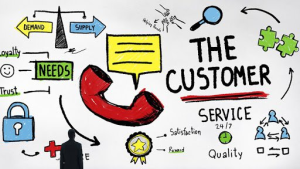Quality Assurance (QA) plays a pivotal role in ensuring that software products not only meet technical requirements but also deliver exceptional user experiences. Customer satisfaction is not just a byproduct of a well-functioning product; it’s a direct result of meticulous QA practices that prioritize user-centric testing and quality standards.

Understanding Customer Satisfaction
Customer satisfaction is the measure of how products or services provided by a company meet or exceed customer expectations. In the realm of software development, this translates into how well an application performs, how intuitive its user interface is, and how reliable and secure it is in handling data and transactions.
The QA Perspective
QA professionals are the gatekeepers of quality throughout the software development lifecycle. Their responsibilities extend beyond detecting defects; they encompass ensuring that every aspect of the product aligns with user expectations and industry standards. Here’s how QA contributes to customer satisfaction:
- Early Detection and Prevention
QA starts its work early in the development process. By identifying potential issues during requirements analysis and design phases, QA helps prevent defects from reaching the end-users. This proactive approach reduces the likelihood of customers encountering critical issues that could affect their experience negatively.
- Ensuring Functionality and Reliability
QA testing ensures that all functionalities of the software work as intended. From basic features to complex workflows, thorough testing validates that the application performs reliably under various conditions. This reliability directly impacts customer satisfaction, as users trust the software to perform consistently without disruptions.
- User Experience (UX) Validation
QA focuses on validating the user experience through usability testing, accessibility testing, and user interface (UI) testing. By simulating real-world user interactions, QA uncovers usability issues, ensures intuitive navigation, and verifies that the interface meets design and accessibility standards. A seamless user experience enhances satisfaction and encourages continued usage.
- Performance and Scalability
Performance testing conducted by QA assesses how the software performs under different load conditions. QA identifies performance bottlenecks, optimizes resource utilization, and ensures the application can handle expected user traffic without slowdowns or crashes. A responsive and scalable application enhances user satisfaction by providing a smooth and efficient experience.
- Security and Compliance
QA plays a critical role in verifying the security and compliance of the software. By conducting security testing, QA identifies vulnerabilities that could compromise data integrity or expose users to risks. Compliance testing ensures that the software meets regulatory requirements and industry standards, providing reassurance to users about data protection and privacy.
- Feedback Loop and Continuous Improvement
QA fosters a feedback-driven culture by gathering insights from testing results, user feedback, and analytics. This feedback loop allows QA teams to identify areas for improvement, prioritize enhancements based on user needs, and iterate on the product to deliver ongoing value. Continuous improvement based on user feedback enhances satisfaction by addressing pain points and evolving with user expectations.
Conclusion
In conclusion, QA is integral to achieving and maintaining high levels of customer satisfaction in software development. By focusing on proactive testing, validating user experience, ensuring performance and security, and embracing continuous improvement, QA not only validates the technical quality of the product but also enhances the overall user experience. Ultimately, a well-executed QA strategy contributes directly to customer loyalty, positive reviews, and sustained business success.
By prioritizing QA as a cornerstone of product development, organizations can align their efforts with customer expectations, foster trust and loyalty, and differentiate themselves in competitive markets. As technology evolves and customer expectations grow, the role of QA in ensuring customer satisfaction remains indispensable.
 End to End Technology Solutions
End to End Technology Solutions
